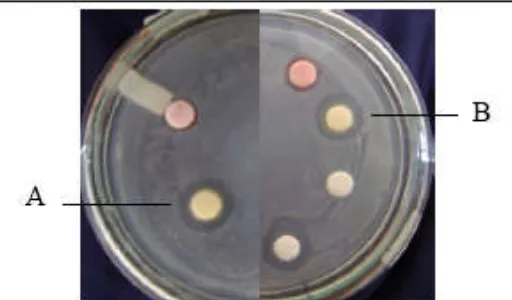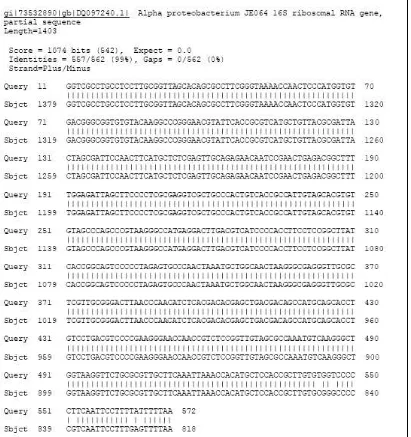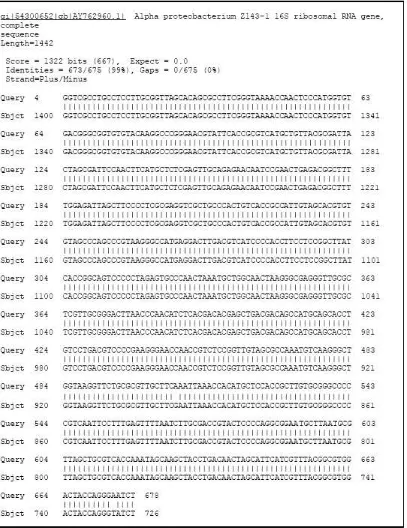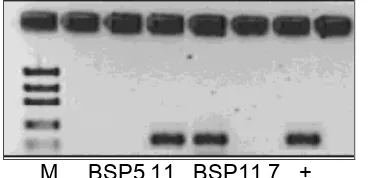Approach
Ocky Karna Radjasa
1,21 Department of Marine Science, Diponegoro University, Semarang 50275, Indonesia 2 Centre for Tropical Coastal and Marine Studies, Diponegoro University, Semarang 50275, Central
Java, Indonesia
Abstract
Staphylococcus aureus is among human pathogens which are known to be resistant to almost clinically significant antibiotics that causes a crisis, in the treatment and management of infectious disease, and also presents a clear danger to the future of public health. Recently, invertebrate-associated microorganisms have become the target of the search for marine microbial natural products. Sponge-associated microorganisms are one of the most interesting natural product sources because they produce bioactive natural products including polyketides and nonribosomal peptides. Molecular approach based on 16S rDNA has been very successful in the identification and the search of secondary metabolite-producing microorganisms, particularly by using specific degenerated primers, for the detection of Polyketide Synthases (PKS) and Nonribosomal Peptide Synthetases (NRPS) gene fragments that are essential for the biosynthesis of bioactive products. Four bacterial isolates from sponge Dysidea sp. were found to inhibit the growth of S. aureus. However, only the best two isolates were selected for further identification and screening for the presence of either PKS or NRPS. The results revealed that both isolates BSP5.11 and BSP11.7 have 99% homology with Alpha proteobacterium. PCR analysis of PKS and NRPS gene fragments showed that they both amplified the NRPS but not the PKS gene fragments.
Keywords: Idenfication, sponge-associated bacteria, Polyketide Synthases Introduction
Marine organisms including those from coral reef ecosystems have become sources of great interest to natural product chemistry, since they provide a large proportion of bioactive metabolites with different biological activities (Faulkner 2000). In particular, marine invertebrates with high species diversity in the Indo-Pacific regions (Coll and Sammarco 1986) are often rich in secondary metabolites and are preferential targets in the search for bioactive natural products (Sammarco and Coll 1992).
Sponges (phylum Porifera) are most primitive of the multicelled animals that have existed for 700–800 million years. Of the approximately 15,000 sponge species, most occur in marine environments. Only about 1% of the species inhabits freshwater (Belarbi
et al., 2003).
Perhaps the most significant problem that has hampered the investigation of secondary metabolites produced by reef’s invertebrates is their low concentration. In marine invertebrates many highly active compounds contribute to<10-6 % of the body-wet
weight. Providing sufficient amounts of these biologically active substances, hence, may be a difficult task (Proksch et al., 2002; Radjasa et al., 2007a,b,c).
The present work is aimed at screening of marine bacteria associated with sponge
Dysidea sp. for the production of secondary metabolites against pathogenic bacterium S.
aureus coupled with PCR-based method for the occurrence of NRPS and PKS gene
Materials and Methods
Colonies of sponge Dysidea sp. were collected from Bandengan water, Jepara, North Java Sea, Indonesia by scuba diving from a depth of approximately 5 meters. Upon collection sponge colonies were put into sterile plastic bags (Whirl-Pak, Nasco, USA) The sponges were then rinsed with sterile seawater and 1 cm2 of sponge tissue was excised
from the middle of the whole sponge and sponge surface after it was peeled off (Radjasa
et al., 2007c) with a sterile knife. The resultant tissues were serially diluted, spread on ½
strength ZoBell 2216E marine agar medium and incubated at room temperature for 48 hours. On the basis of morphological features, colonies were randomly picked and purified by making streak plates (Madigan et al., 2000).
To screen their biological activity, a total of 98 sponge isolates were tested against pathogenic bacterium S. aureus. One 100 µl culture of indicator microorganism in the logarithmic phase (ca. 109 cells ml-1) was spread on to agar medium. Several paper disks
( 8 mm; Advantec, Toyo Roshi, Ltd, Japan) containing 30 µl of the sponge bacterial strain were placed on the respective agar surface. The plates were then incubated at room temperature for 48 hours. Antibacterial activity was defined according to Radjasa et
al., (2007a) by the formation of inhibition zones greater than 9 mm around the paper disk.
To obtain genomic DNA of secondary metabolite producing-strains for PCR analysis, cell materials were taken from an agar plate, suspended in sterile water (Sigma, Germany) and subjected to five cycles of freeze (-80°C) and thaw (95°C). Amplification of peptide synthetase gene fragments was carried out with the NRPS degenerated primers A2gamF (5´-AAG GCN GGC GSB GCS TAY STG CC-3´) and A3gamR (5´-TTG GGB IKB CCG GTS GIN CCS GAG GTG-3´) (Marahiel et al., 1997) and PKS degenerated primers KSDPQQF (5´-MGN GAR GCN NWN SMN ATG GAY CCN CAR CAN MG-3´) and KSHGTGR (5´-GGR TCN CCN ARN SWN GTN CCN GTN CCR TG -3´) (Piel, 2002).
PCR was performed with an ProgeneThermal cycler (Techne, Burkhardtsorf, Germany) as follows: 1 µl template DNA, 1 µl of each of the appropriate primers, and 23 µl DNA free water (Fluka, Sigma-Aldrich Chemie GmbH, Germany) were added to puReTaq Ready-To-Go PCR beads (Amersham Biosciences Europe GmbH, Germany). The NRPS-PCR run comprised 40 cycles with denaturing conditions for 1 min at 95°C, annealing for 1 min at 70°C and extension for 2 min at 72°C, respectively. Pseudomonas
sp. DSM 50117 was used as positive control. The amplification of PKS gene fragments included an initial denaturating step at 94°C for 2 min, followed by 45 cycles at 94°C for 1 min, annealing at 55°C for 1 min and elongation at 72°C for 2 min. Bacillus subtilis 168 was utilized for positive control.
Amplification was conducted according to method of Radjasa et al (2007a). Genomic DNA of secondary metabolite producing-strains for PCR analysis were obtained from cell materials taken from an agar plate, suspended in sterile water (Sigma, Germany) and subjected to five cycles of freeze (-80°C) and thaw (95°C). PCR amplification of partial 16S rDNA of sponge bacteria, purification of PCR products and subsequent sequencing analysis were performed according to the method of Radjasa et al (2007b). The determined DNA sequences of strains were then compared for homology to the BLAST database.
Results and Discussion
Table 1. Inhibitory interaction of sponge associated-bacteria against S. aureus
Isolate Diameter of inhibition zone (mm) Average
1 2 3
Molecular identification based on 16S rDNA approach was carried out only on two isolates showing the best growth inhibition (Tabel 1 and Fig 1) and the results showed that the two active isolates are the member of Alpha proteobacterium (Table 2).
Fig 1. Zone inhibition on S. aureus lawn by sponge-associated bacteria. (A). BSP5.11, (B) BSP11.7
Table 2. Molecular identification of the best two active isolates
No Isolate Acc. Number Closest relative Homology (%) 1 BSP5.11 DQ097240 Alpha proteobacterium JE064 99 2 BSP11.7 AY762960 Alpha proteobacterium Z143-1 99
As shown in the Table 2, both isolates BSP5.11 and BSP11.7 had high homologies
to Alpha proteobacteria (99%). The detailed alignments of DNA sequences both isolates
are shown in the Figure 2 and 3.
One of the active isolate BSP11.7 showed a high homology to Alpha
proteobacterium Z143-1(99%), a marine bacterium isolated from Philippine tunicate that
produce anti-Staphylococcus aureus metabolite heptylprodigiosin (de Guzman, unpublished). Interestingly our isolate BSP.11 also inhibited the growth of tested strain S.
aureus. On the other hand, isolate BSP5.11 had closest relation with Alpha
proteobacterium JE064 (Acc. No. DQ097240), a culturable Alphaproteobacterial symbiont
of many marine sponges collected from geographically different regions , namely Axinella
corrugata, Mycale laxissima, Monanchora unguifera, and Niphates digitalis from Key
Largo, Florida; Didiscus oxeata and Monanchora unguifera from Discovery Bay, Jamaica;
an Acanthostronglyophora sp. from Manado, Indonesia; and Microciona prolifera from the
Cheasapeake Bay in Maryland (Enticknap et al, 2006).
Furthermore, Hentscel et. al (2002), reported that Alpha proteobacterium was also found in association with Theonella swinhoei, Aplysina aerophaba, Rhopaloides odorabile
dan Halicondria panicea. The finding that Alpha proteobacterium dominated the sponge
Rhopaloides odorabile in geographically different area, has confirmed that this associated
Figure 2. The DNA alignment showing the homology of isolate BSP5.11 and Alpha
proteobacterium JE064 based on BLAST search.
Polyketides and non-ribosomal peptides are two of the largest groups of multifunctional proteins that create a multitude of secondary metabolites (Hutchinson, 2003), many of them are used as therapeutic agents (Piel et al., 2003). Products of the microbial non-ribosomal peptide synthesis include the immunosuppressant cyclosporine and other antibiotics such as gramicin S, tyrocin A and surfactins (Kleinkauf and von Doehren, 1996). Among clinically important polyketides are the antibiotics aunorubicin, erythromycin, lovastatin and rapamycin (Due et al., 2001).
Figure 3. The DNA alignment showing the homology of isolate BSP.11.7 and Alpha
proteobacterium Z143-1 based on BLAST system.
M BSP5.11 BSP11.7 +
Figure 4.PCR amplification of NRPS gene fragments;+control Pseudomonas sp DSM 50117
The discovery of the potential for the synthesis of peptides among sponge-associated bacteria in particular the member of Alpha proteobacteria, should be of interest because of promising applications in the development of pharmacological peptides. Furthermore, considering the fact that research on sponge-bacteria association has been fairly limited , the future study on the search for secondary metabolite producers among coral colonizers should be given prominence.
Conclusion
In conclusion, sponge Dysidea sp. exhibited secondary metabolite producing-marine bacteria with antibacterial potential against S. aureus. The present study highlighted the PCR-based method by using specific degenerated primers NRPS and PKS as a powerful tool in estimating the genetic potential of sponge associated-bacteria that is essential in the biosynthesis of secondary metabolites.
Acknowledgements
This work partly supported by a research grant from Ministry of Research and Technology within Indonesian International Joint Research Grant Program (RUTI III) in the marine research area. We acknowledged the financial supports from Lindbergh Foundation, USA and Indonesian Biodiversity Foundation (KEHATI).
References
Belarbi E.H, A. C. Go´mez, Y. Chisti, F. G. Camacho, and E. M. Grima. 2003. Producing drugs from marine sponges. Biotechnol. Adv. 21: 585–598
Coll J.C, and P.W Sammarco, 1986. Soft corals: Chemistry and ecology. Oceanus 29 (2): 33-37
Due, L, Sanchez C, Shen B. 2001. Hybrid peptide-polyketide natural products: biosynthesis and prospects toward engineering novel molecules. Metabol Engineer 3:78-95
Enticknap, J.J., M. Kelly., O. Peraud., and R.T. Hill. 2006. Characterization of a culturable alphaproteobacterial symbiont common to many marine sponges and evidence for vertical transmission via sponge larvae. Appl. Environ. Microbiol. 72 (5), 3724-3732. Faulkner D.J, 2000. Marine pharmacology. Anton Leeuw Int J G. 77:135-145
Hentschel, U., J. Hopke, M. Horn, A.B. Friedrich, M. Wagner,, J. Hacker, and B.S. Moore. 2002. Molecular evidence for a uniform microbial community in sponges from different oceans. App. Environ. Microbial. 68: 4431-4440
Kleinkauf H, von Doehren H. 1996. A nonribosomal system of peptide biosynthesis. Eur J Biochem236:335-351
Lee, Y.K., Lee, J. H. and Lee,. H. K. 2001. Microbial symbiosis in marine sponges. J.
Microbiol. 39(4):254-264.
Madigan M.T, J.M. Martinko, J. Parker, and T.D. Brock, 2000. Biology of microorganisms. Prentice-Hall, Inc., New Jersey, USA
Marahiel M.A, Stachelhaus T, Mootz H.D.1997. Modular peptide synthetases involved in nonribosomal peptide synthesis. Chem Rev 97:2651-2673
Piel J. 2002. A polyketide synthase-peptide synthetase gene cluster from an uncultured bacterial symbiont of Paederus beetles. PNAS 29:14002-14007
Piel J, Hui D, Fusetani N, Matsunaga S. 2003. Targeting modular polyketide synthetase with iteratively acting acyltransferases from metagenomes of uncultured bacterial consortia. Environ Microbiol 6:921-927
Proksch P, R.A. Edrada, R. Ebel, 2002. Drugs from the seas-current status and microbiological implications. Appl Microbiol Biotechnol. 59:125-134
Radjasa, O.K., T. Martens., H-P. Grossart, T Brinkoff., A Sabdono., and M. Simon. 2007a. Antagonistic activity of a marine bacterium Pseudoalteromonas luteoviolacea
TAB4.2 associated with coral Acropora sp. J. Biol. Sci.7(2):239-246.
Radjasa, O.K., S.I.O. Salasia, A. Sabdono, J. Weise,J. F. Imhoff, C. Lämmler and M. J. Risk. 2007b. Antibacterial activity of marine bacterium Pseudomonas sp. associated with soft coral Sinularia polydactyla against Streptococcus equi subsp.
zooepidemicus. Int. J. Pharmacol. 3(2):170-174.
Radjasa, O.K., A. Sabdono, Junaidi and E. Zocchi. 2007. Richness of secondary metabolite-producing marine bacteria associated with sponge Haliclona sp. Int. J.
Pharmacol. 3(3):275-279.



